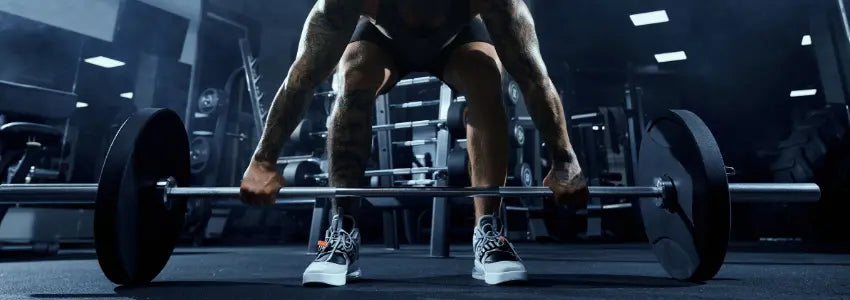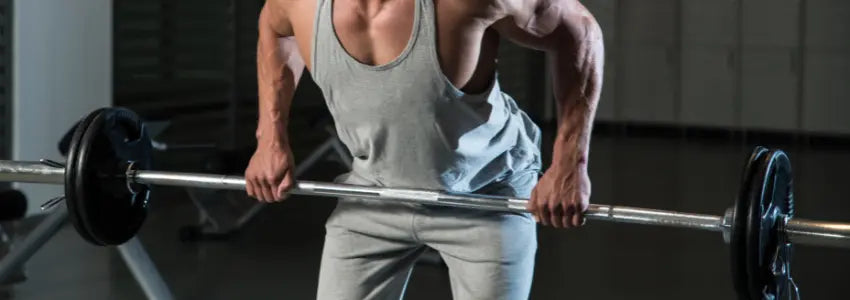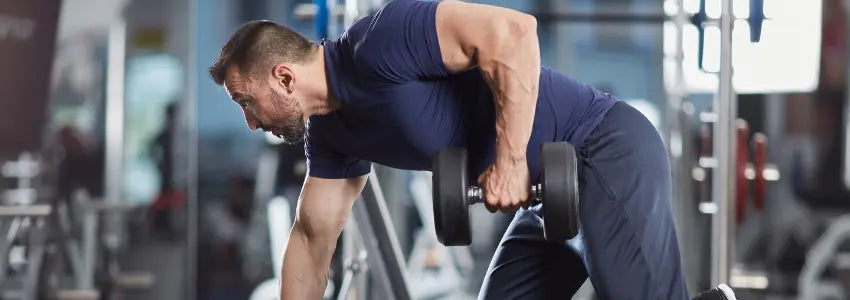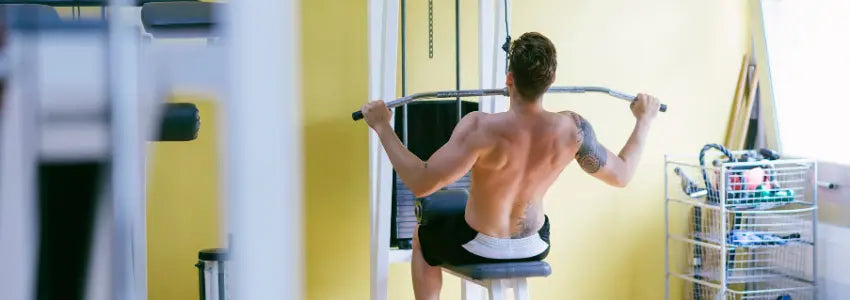Back Attack - 6 Major Back Exercises to build a V-Taper
Nowadays, almost every second person wants to go or already goes to the gym. However, not everyone is able to make the body they desire. But, we are not here to talk and learn about muscle building of the whole body, or about the successful and unsuccessful weight loss journeys. We are here to talk about the infamous and desirable V-Taper. If you are someone who desires to build a V-Taper back, then this blog is perfect for your workout journey.
What is a V-Taper?
V-Taper is one of the most popular physical characteristics desired by both bodybuilders and regular gym goers. It is called a V taper because of its physical shape, i.e. a V shaped back. This particular back can be built by specific exercises, fat loss, weightlifting techniques, and nutrition intake.
Anatomy of your Back:
Let's discuss the muscles present in upper and lower backs:-
Upper Back- Contains muscles like rhomboids, trapezius, teres and upper part of the latissimus dorsi.
Lower Back- Contains muscles like Lower latissimus dorsi and lower regions of erector spinae.
To build the most sought after V shaped back one majorly needs to develop 4 muscles. The width can be developed by latissimus dorsi and teres major. Whereas, the thickness can be developed by running rhomboids, and erector spinae. Though, it is necessary to work on all of them and more to get the best results.
Now, let's discuss the exercises that can help in these muscle developments in detail.

1) DEADLIFT- A Deadlift is one of the best things you can do to build your back muscle. It stimulates erector spinae muscle that is part of your lower back, and affects the thickness of your back. Deadlifts are really engaging exercises and engage various muscles present at different parts of the body. It affects most of the back, abdomen, thighs and buttocks.
It is a moment that we practice while doing many normal day chores such as lifting shopping bags or a heavy box from the floor.
Let’s see how to do a deadlift safely:
Starting Position:
- Keep your feet and shoulders a width apart and stand facing towards the barbell, with your feet flat on the ground.
- Now contract your abdominal muscles, push your chest up and keep your back straight and bend your knees or squat till you are able to reach the bar.
- Use a pronated grip to hold the bar. Make sure that your hands are gripping the bar at wider positions than the shoulder. Use the rings on the bar dumbbell to navigate.
- Make sure your back is straight or arched slightly and not rounded at the shoulders or spine.
- Ensure that your grip is tight, your abdominals and lower back contracted, chest lifted up and back straight. Fix your eyes on a point in front of you, inhale and hold your breath.
How to perform this exercise:
- Now use your legs and knees to push upwards. Do not raise your hips first to avoid the trunk moving forward and the back becoming rounded. Don’t try to haul the bar up with your arms. The arms stay extended under tension while gripping the bar as the legs push up. Move your shoulders and legs upwards in unison, with your hips being the balance point.
- Stop once you are standing upright. Do not overexert your back and muscles. Make sure that your hips and shoulders are in a straight line.
- Hold this position for 2-4 seconds, while bringing your scapula together for more back stimulation.
- Now, bring the barbell back to the ground in a reverse motion while maintaining a straight back.
Note:- It is vital to do plenty of warm up sets before going for heavy weight deadlifts, to prevent any tears.
During your warm up do multiple reps with lighter weights, slowly build up to heavy weights and take sufficient rests between sets.
There are many different kinds of deadlifts that can be performed:-
- Dumbbell Deadlifts- If one does not have access to a barbell or the weight on the barbell is too heavy for them, they can try and use a kettlebell or vertical dumbbell deadlift with a lighter weight.
- Romanian Deadlifts- In this the deadlift starts in a standing position rather than a squatting position. This lift works on the posterior chain muscles, these are the muscles that run along the back of the body such as glutes, hamstrings and calves.
- Stiff Leg Deadlift- In this version of deadlifts one remains in standing position, with the legs stiff and the knees almost locked. Maintain a neutral spine and keep the bar close to your body as you bend forward and return to standing.
- Suitcase Deadlift- In this technique you lift the weight on one side of the body at a time, using only one hand. It helps in strengthening the core.

2) BARBELL ROWS- This exercise is one of the best when it comes to doing heavy weight exercises (rowing exercises) for building a V - Taper. The movement stimulates trapezius, rhomboids, teres major and latissimus dorsi. Due to the freedom of changing the position between torso and the floor during exercises one can easily throw in some extra cheating reps and boost the workout intensity.
Starting position-
- Start by leaning forward and forming a 45 degree angle between the torso and the floor, with a slight bent in the knees. Performing the workout with a greater angle has an impact on the lower back muscles, whereas one can work on the trapezius muscles by forming a smaller angle. One needs to try a few positions to find the most optimal position for their bodies.
- Put your hands on the barbell with almost a shoulder width apart, in a pronated grip (thumbs facing each other) and make sure that your shoulders are just a few inches higher than your hips.
- Make sure to keep your chest pushed up, back straight and head kept straight, looking in front of you.
How to perform this exercise:
- Exhale and pull the barbell towards your torso. Use your shoulder blades and lower back to pull the bar bell. Your biceps and forearms should only be used for holding the weight, do not contract them.
- The elbows will lift up and bring your shoulder blades together. Keep your core strong. The bar will touch the bottom of your ribcage at the highest point. Hold this contraction for 2 seconds.
- Now, slowly release the bar back down to the ground until the arms are fully extended and repeat.
Do 2-3 sets of 8–10 repetitions per set.

3) DUMBBELL ROWS- This exercise engages muscles like latissimus dorsi, rhomboids, teres major and trapezius. They are great for building a wide and thick back. It is also great for core strengthening as one is required to perform this exercise with a rigid torso, without spine rotation or spine flexion.
Starting Position-
- Place your dumbbell on the right side of a flat bench. You will be using this bench for support during the exercise.
- Now, put your left knee on the lower part of the bench, bend your waist and put your left hand on the upper part of the bench.
- Make sure to keep your abdomen strong, your back straight and your torso almost parallel to the floor.
- Now grab the dumbbell with a neutral grip (thumbs facing upwards) by lowering yourself towards the floor.
- Now without rounding your back, lift yourself up while maintaining a small bend in the elbow.
How to perform this exercise:
- Now, drive your elbow as far back as you can and pull the dumbbell up. Make sure that your torso is rigid for the entire moment, the dumbbell travels in a straight line, close to your body and brushes against your hip at the peak of the moment.
- Hold the dumbbell at the top for a second, focusing on contracting your lats, rhomboids and traps. Your scapula should be retracted (drawn back in) as far as possible.
- Gradually lower the dumbbell, allowing your shoulder blades to elongate. Go as low as you can without tilting your back to the side.
- Pause briefly and hold the stretched position.
- Do not take a break, and repeat the exercise using the left arm (dumbbell on the left, right knee and arm on the bench)
- Both the moments combined completes one set.
Perform 3-4 sets of 10-12 reps.

4) CABLE LAT PULL- DOWNS- These are an excellent exercise for building back width as it mainly targets latissimus dorsi and teres major. However, with a few modifications in the routine one can also target rhomboids and lower trapezius muscles for extra back thickness.
This workout is performed at a workstation with adjustable resistance, like plates.
This exercise is a great alternative for chin ups, which is a very difficult exercise for beginners.
Starting Position-
- To start, attach a wide bar to the pulley and adjust the knee pad of the machine. The knee pad enables you to secure your thighs in place, preventing the weight of the stacks from lifting you upward.
- Now, grab the bar with a pronated grip (both the thumbs facing towards each other.) and place your hands slightly wider than shoulder width.
How to perform this exercise:
- Keep your shoulders and hips in line, lower your head and let the weight stretch your back. Concentrate on loosening your lats and allowing them to stretch fully. Hold this stretched position for a second.
- Now bring your head back up and pull the bar down until it's approximately in line with your chin. Exhale on the downward position and engage your abs as you pull. Try to keep your upper torso stationary during the motion.
- The bottom of the movement should be when your elbows reach their furthest point downward and cannot move further without shifting backward. It is crucial to stop the motion at this juncture and avoid descending further.
- Now, focus on squeezing the shoulder blades together and hold this contraction for a second.
- From the bottom position, slowly reverse the moment back to the starting position. Do not let the bars crash.
You can use this exercise with light weights and pyramiding them up to warm up and isolate your lats. Continue until you complete eight to 12 repetitions in a set. Rest, then continue to complete your program of sets.
5) BARBELL SHRUGS- This particular exercise can help you in developing your neck muscles. If you are someone who finds their necks to be too slender or just doesn't like to have a long neck, then this exercise is one of the best for you.
As the trapezius muscle gets stimulated by different back exercises. This exercise can really boost its development.
Starting Position-
- Start by standing shoulder width apart and facing towards the dumbbell.
- Now straighten your spine, contract your abdominals, push your chest out and bend your knees till you can reach the bar.
- Now, use a pronated grip to grab the bar, and make sure to keep your hands shoulder width apart.
- Fix your eyes in front of you, keep your abdominal muscles and back contracted and prepare to lift the bar.
How to perform this exercise:
- Begin lifting the bar from the floor by straightening your legs, ensuring that the bar remains close to your body. As the bar reaches knee level, straighten your legs further while extending your back simultaneously.
- Keep your arms rigid and try to lift your shoulders (shrug) as high as you can. Try to think about it like burying your head into your shoulders while keeping your neck stationary.
- Hold this contraction for 3 seconds, and focus on squeezing your back muscles as intensely as possible.
- Now, lower the barbell down to the floor and let it stretch your trapezius muscles.
- Repeat the entire sequence from step 2 for the desired number of repetitions
Perform 3-4 sets consisting of 10-15 repetitions each, ensuring you hold the contraction for a minimum of 3 seconds.
6) BENT ARMS DUMBBELL PULLOVER- This exercise serves as the best way to complete your back workout as it enables you to stretch your lats with heavy loads. Though there is not enough scientific evidence available regarding the loaded stretch effect on muscle hypertrophy, many physique athletes believe it can promote muscle expansion, albeit anecdotally.
Regardless of the validity of this belief, the flexibility developed through this exercise can help prevent injuries and enhance mobility, providing additional benefits beyond potential muscle growth.
Starting Position-
- Start by positioning the dumbbell upright on the edge of a bench.
- Then lie down on your back across the bench, and ensure that only your shoulder blades make contact with its surface. It's important to keep your neck off the bench to avoid cervical spine injuries.
- Now, place your feet securely on the ground and lower your hips.
- Grab the dumbbell with both hands, pressing your palms against the inner side of the weight plates. For a secure grip, wrap your thumbs around the handle and curl your fingers around the edge of the dumbbell.
How to perform this exercise:
- Now position the dumbbell above your head and bend your elbows slightly. Maintaining a straight arms may engage more of your chest muscles rather than your back.
- Keep your arms straight, and gradually lower the dumbbell behind your head until you reach a comfortable depth.
- Hold the stretched position for a second, then raise the dumbbell back up until it is positioned above the top of your head. Bringing the dumbbell just short of your forehead will place greater emphasis on your back muscles.
- Squeeze your chest muscles and hold the contraction for a second before repeating the movement.
Aim for 2-3 sets of 12 repetitions, focusing on the stretching sensation during the exercise.
To conclude, for some people developing a wide and thick back is necessary for enhancing the overall aesthetics of their physique, creating the coveted v-taper illusion that accentuates a small waist and impressive size. To achieve this, a well planned approach to back training is essential, so that one can target various groups of muscles and train them accordingly.
Even though exercises like pull-ups are beneficial, they alone may not suffice for optimal back development. It's crucial for both novice and seasoned trainees to reassess their exercise form to maximize results and minimize the risk of injury. By delving into the anatomy of the back muscles, we understand the importance of targeting each muscle group to ensure balanced development and prevent imbalances.
From the powerhouse movement of deadlifts to the focused isolation of cable lat pull-downs, incorporating a variety of exercises is key to effectively stimulating all areas of the back. Additionally, understanding the nuances of each exercise, such as grip variations and body positioning, allows for tailored training to address individual needs and goals.
Consistency and attention to detail are paramount in back training, whether it's through compound movements like barbell rows or unilateral exercises like dumbbell rows. Each exercise serves to challenge and strengthen different aspects of the back, contributing to overall muscle growth and definition.
Incorporating these exercises into your training regimen, along with proper form and progressive overload, will yield substantial improvements in back development over time. By embracing the principles outlined in this article, you'll be well-equipped to sculpt a powerful and impressive back that complements your physique and enhances your overall strength and athleticism.












Leave a comment
All blog comments are checked prior to publishing